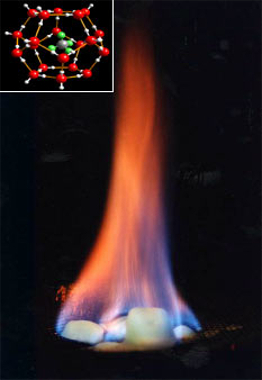In the illustration above we see what looks like pieces of snow that are on fire. Is this really possible? Yes, it is, and not just with ice cubes, but even in liquid water, as occurs in some lakes and rivers. An example is the Rio Branco, which is located 300 km north of Cuiabá, in the Amazon region, in the state of Mato Grosso. Visitors can see fire generation on the river's surface.
In the year 1996, German researchers Erwin Suess, Gerhard Bohrmann and Jens Greinert collected samples of what looked like snow from the mud of the bottom of the Pacific Ocean that was on fire. Furthermore, for the first time in history, in March 2013, a Japanese ship, after years of research, managed to extract this “burning ice” from a depth of 1 km.
However, it is clear that these are not normal ice cubes, in fact, what makes them catch fire is a substance called methane hydrate, which is white, and looks a lot like ice.
Methane (CH4) is a gas produced through the decomposition of organic matter such as dead plants and animals. At the bottom of the oceans, where the pressure is much higher and the temperature is low, there is a favorable environment for microorganisms to synthesize organic matter and produce methane. This gas is then encapsulated by ice crystals.

When it is close to the freezing temperature of water, methane hydrate is quite stable. But at room temperature, it decomposes quickly, releasing methane, which is quite flammable.

In the case of the Rio Branco mentioned, the organic matter from the forest is very large and falls
in this river, generating large amounts of methane gas, which forms bubbles on the surface. When you move the bottom of the river, it releases even more gas that can be burned.
Now the most interesting point of “ice that catches fire” is that the energy stored in it can be a potential source for energy generation. In addition, its reserves are far greater than those of fossil fuels, as they are in all oceans.
Japan even said it expects to start production in six years. But there are some downsides, such as the difficulty of extracting methane from deep. very large, it is not always economically viable and worst of all: methane gas is highly pollutant. Its escape to the atmosphere in the extraction process would aggravate problems such as the greenhouse effect and global warming. This is because methane is also a greenhouse gas, that is, it absorbs the sun's heat reflected by the earth's surface and, in addition, reacts with the free oxygen present in the atmosphere, producing carbon dioxide, which is currently the main cause of the effect. stove.
By Jennifer Fogaça
Graduated in Chemistry
Source: Brazil School - https://brasilescola.uol.com.br/quimica/o-gelo-que-pega-fogo.htm

